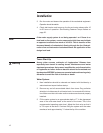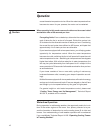
20
Cooling Tower Cleaning:
Any evaporative-type cooling tower must be thoroughly cleaned on
a regular basis to minimize the growth of bacteria, including Legio-
nella Pneumophila, to avoid the risk of sickness or death. Service
personnel must wear proper personal protective equipment during
decontamination. Do NOT attempt any service unless the fan motor
is locked out.
Operators of evaporative cooling equipment, such as water cooling tow-
ers, should follow maintenance programs which will reduce to an absolute
minimum the opportunity for bacteriological contamination. Public Health
Service ofcials have recommended that “good housekeeping” procedures
be followed, such as: regular inspections for concentrations of dirt, scale,
and algae; periodic ushing and cleaning; and the following of a complete
water treatment program including biocidal treatment.
The visual inspection should take place at least once a week during the
operating season. The periodic ushing and cleaning should be done be-
fore and after each cooling season, but in any event at least twice a year.
The louvers, drift eliminators, and easily accessible ll surfaces should
be ushed by use of a moderate-pressure water nozzle, being careful not
to cause physical damage. A reliable water treatment program should be
installed and maintained. Filtration devices may be employed to reduce the
suspended solids concentrations, thus increasing the effectiveness of the
water treatment program. See Tower Startup instructions on page 12.
Blowdown:
A cooling tower cools water by continuously causing a portion of it to
evaporate. Although the water lost by evaporation is replenished by the
makeup system, it exits the tower as pure water—leaving behind its burden
of dissolved solids to concentrate in the remaining water. Given no means
of control, this increasing concentration of contaminants can reach a very
high level.
In order to achieve water quality which is acceptable to the cooling tower
(as well as the remainder of your circulating water system), the selected
water treatment company must work from a relatively constant level of
concentrations. This stabilization of contaminant concentrations is usually
accomplished by blowdown, which is the constant discharge of a portion of
the circulating water to waste. As a rule, acceptable levels on which to base
a treatment schedule will be in the range of 2-4 concentrations. The following
Operation
Warning


















